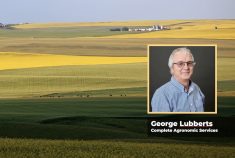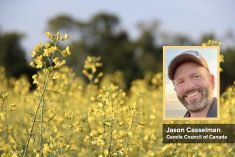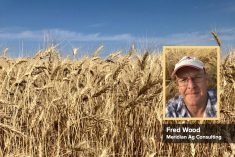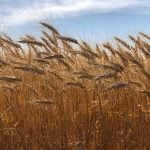As trends go, this one is picking up steam. Two years ago, it seemed a novelty. You were lucky to see it outside of a few test locations such as at Canada’s Outdoor Farm Show, although there were also isolated growers who had become believers, especially in Quebec.
Today, the movement has clearly spread, not just attracting more growers but also with more research and even with some specialized equipment manufacturers getting into the picture.
Anne Verhallen, soil management specialist for horticulture crops with the Ontario Ministry of Agriculture, Food and Rural Affairs (OMAFRA), agrees the amount of learning in the past two years is extraordinary, with experience gained in Ontario and Quebec, as well as in Pennsylvania and Illinois, among others.
Read Also

Could crop sharing be a viable option for your farm?
Crop sharing could be a good option for young and beginning farmers.
In 2014, an article in Country Guide’s Forage & Grasslands Guide scratched the surface on inter-seeding covers, noting that seeding dates should coincide with a fungicide application on the corn in late summer. That thinking has changed, however, as have the recommended species, the importance of herbicide programs, and the machinery designs that are available.
“The first thing on the to-do list is to look at your field and figure out what the weed concerns are, and what herbicide program you can live with,” says Verhallen. “That will determine what you can inter-seed, particularly whether it’s a legume, ryegrass or a mix.”
Then comes the timing, which now offers three options: early, post-tassle and after harvest.
Verhallen has found some growers in Quebec and Ontario are moving to the early timing, and they’re sometimes going on earlier than expected — around V4 to V5 (four- to five-leaf collars). “There are some who are playing with time frames that are earlier than that, but I think you’re cutting it fine with the 30-day weed-free period,” says Verhallen.
However, the V4 to V5 timing does open the door for simpler equipment designs, so growers don’t need an expensive high-clearance spreader-type machine.
Timing also determines the species a grower can plant. Verhallen notes that annual ryegrass appears to be the popular choice for earlier seeding, with other options including clovers (red or crimson) or alfalfa. With later timings, growers might consider cereal rye or oats since cereal rye is more likely to establish and would achieve the greatest growth after corn harvest.
Summer and winter
The past two summers and this past winter have been excellent for inter-seeded cover crops. In particular, summer rains have been timely and soil conditions have been favourable, which means that if the summer of 2016 turns dry in July and August, growers might be disappointed. By the same token, this past winter has been relatively mild and with less snow cover, allowing remarkable growth of some general cover crops as well as the inter-seeded covers. That raises some concern of how to kill annual ryegrass in a timely fashion (there is a resource that’s been developed by Mike Cowbrough of OMAFRA).
That’s not meant to discourage growers from trying to inter-seed into standing corn, just because the weather conditions might not be as ideal as in the past two years. As most growers who are engaged in the practice will agree, a lot depends on what you’re hoping to accomplish with these or any types of cover crops. Yet they also argue that inter-seeding is another management layer, one that requires a longer-term commitment to see the full benefits.
Gerard Grubb, Mildmay, Ont.
A dedicated no-tiller, Gerald Grubb believes many valuable practices take time and commitment to pay off. He has heard the critics who talk of yield losses or yield drags with no till. Yet in his experience, he’s found it’s the other way around. But then he also maintains that no till isn’t no till until the ground’s been untilled for three or four years, allowing the biology in the ground to change.
Now he believes the same is true for inter-seeding.
“I believe it’s going to work best in a no-till situation because you have the cover crop there, and you have a different soil set to start with,” says Grubb. “In worked ground, that top ground is going to dry out, and I’d be concerned that it’d dry out faster. I have a three-year rotation and if it gets into corn, I’ll have my ground covered all the time.”
When it comes to getting started, Grubb agrees with Verhallen’s ranking of the considerations for inter-seeding, particularly the herbicide program. If that isn’t set up properly and tailored to the cover crop species, Grubb says a grower might as well forget it.
As for the species choice, he has worked with ryegrass for the past two years and likes its ability to thrive in limited sunlight. Second choice for him is crimson clover, which he’ll mix in this year to test its survivability. And as for timing, his first two attempts were planted at the six-leaf stage in June, always watching the weather forecast and trying to seed right before it rains.
On the machinery front, Grubb is something of an innovator, like many of the growers who are making this work. He’s been no till since 2000 and his goal since then has been to build soil organic matter. Six years ago, he went to strip till because he found broadcasting fertilizer wasn’t practical. This past winter, he took the spray tank off his Spra-Coupe and combined it with a Valmar seeder that he purchased.
“I’m going to be blowing down between the rows at the six-leaf stage, hopefully right before a rain,” says Grubb. “We put the Valmar unit on in January, and we’ve used it to spray red clover on wheat, and it’s my dream machine, because I can do about 80 acres of red clover into wheat in about 50 minutes.”
Grubb believes it will work fine, and to justify putting $30 an acre into cover crop, he knows there’s always the question of where and how he’ll recoup that investment.
“But if you’re farming your own ground, or you’re going to be farming rented ground for a number of years, it’s going to have a good payback,” Grubb says. “Not only that, it’s something that we have to start doing and advertising to the consumer that this is a public relations exercise and we’re working on this phosphorus issue.”
Ken Schaus, Elmwood, Ont.
Although he’s only had one year’s experience inter-seeding cover crops into corn, Ken Schaus believes he’s found a perfect system for keeping his fields green. A cash cropper and beef cattle producer, Schaus has seen remarkable results from his efforts. It all began four years ago, when he shifted to shallow tillage equipment and decreased fall tillage to the point where he hasn’t done any in the past two years.
Now, 95 per cent of his ground is in cover crops, and as much as he’d like to go to complete no till, his beef cattle operation means they have lots of manure to deal with.

Schaus has also found that by decreasing tillage, adding covers and now inter-seeding covers into corn, the mat of green growth seems to support the machinery much better. There are no ruts and his tires don’t clump with mud, there are no signs of erosion in the fields, and the spots where he used to see standing water are comparatively dry. Once the corn is combined, says Schaus, the field greens up, usually within 10 days.
Granted, it’s due to the combination of reduced tillage plus cover crops and now inter-seeding, yet Schaus says the results are obvious. Just before and at Christmas, he dug up several corn plants and examined the root balls. What he found was a vast network of annual ryegrass roots intertwined through the mass. On some, the roots ran 25 inches deep.
“The results are very good and I’ve no regrets,” says Schaus, noting he inter-seeds at the five-leaf (V5) stage while side-dressing his nitrogen. On a full cover crop program in standing corn, with 10 pounds of ryegrass and three pounds of crimson clover, he’s spending about $25 to $28 on seed, and the APV air seeder on his side-dress unit costs about $3 an acre, with ownership and fill time, for a $30 investment for corn-on-corn ground, he says. “If you put that into tillage terms, that doesn’t buy very much.”
His ideal rotation is corn-corn-soybeans-wheat, with no yield drag on the second-year corn. It’s important to Schaus that the ground isn’t worked any more than necessary, and to have something covering it all the time.
When it comes to expanding the cover species, Schaus likes to keep things simple, and he recommends others do the same by avoiding multi-blends or anything exotic to start. Last year on June 10, he put several strips and checks into corn that was planted May 1. He tried oilseed radish, which he found disappointing, and the more species he added to the mix, the poorer response he saw. His best mix was crimson clover and annual ryegrass, with annual ryegrass doing well on its own.
“I was concerned about going in too soon with the cover crop, but I think that on the 10th of June, 40 to 45 days after planting, we had no issue,” says Schaus. “If you wait too long, the corn’s going to be too tall and if you just miss a couple of rains in June, a lot of that seed is going to lay dormant or get eaten.”

The plan going forward is to inter-seed ryegrass and crimson clover in the first year and with ryegrass in the second year. The third year will be soybeans followed by wheat, followed by a three-way or four-way cover crop, depending on how much feed he wants to make for the next year. He also has it to the stage where he can apply as much manure as possible on to that wheat ground, and have the cover crop soak that up, and fix it, too.
Last, Schaus wants it known that farmers have a wealth of resources available to them, be it through organizations such as Innovative Farmers Association of Ontario (IFAO), the local chapters of the Ontario Soil and Crop Improvement Association and OMAFRA staff. He’s also been able to connect with growers and other advisers on Twitter (@kenschaus), and likes to stay connected and share his experiences while learning from those of others.
Laurent Van Arkel, Dresden, Ont.
Laurent Van Arkel spends a lot of time talking about cover crops and sharing his experiences, often hosting on-farm visits or travelling to someone else’s farm to learn more about what’s working for them. The 2016 growing season will be his sixth year inter-seeding covers into corn, and his advice to beginners echoes that of others: to keep things simple and to work to understand the relationships between cover species, herbicide programs and timing.
“You have to understand how to deal with the cover, how it’s going to act in the spring, and how you’re going to deal with it,” says Van Arkel, who works a standard rotation of corn-soybeans-wheat, plus sugar beets, and some finishing hogs. “And next would be your herbicide program — you’re going to have to understand that.”
As Verhallen states, that then relates to the timing. For Van Arkel, it means inter-seeding in June. Leaving it later until August or September means a grower likely has to call in an aerial applicator. On one hand, that limits the species — annual ryegrass is too light for that delivery method so a cereal rye might be better. On the other hand, the herbicide issue is less significant later in the summer, but then the amount of sunlight penetrating to the ground is diminished.
“To me, timing is critical. Six-leaf stage is the weed-free period, so I like to go in right around then, and assuming emergence of the cover crop within a week, that should be past the critical weed-free period,” says Van Arkel.
As for species, annual ryegrass is one he likes, particularly since it resists shade. Van Arkel is also working with red and white clover to determine the best blend. Thus far, he’s found eight pounds of annual ryegrass and two pounds of clover works well when applied and incorporated. If he were to broadcast, he’d increase the rate of clover to four pounds.
To ensure a good cover stand on his farm, good seed-to-soil contact is essential, so Van Arkel’s plan for 2016 is to use a double-disc opener configuration which he modified earlier this year. Prior to that, he’d been dropping seed in front of a Lewiston roller, but he notes that there are specific speeds (six to eight m.p.h.) to get any type of soil movement. And at that speed, it’s more likely he’d cause some damage to his corn.
“There are lots of guys who are mounting air seeders on side-dress bars, or on cultivators if you’re more conventional,” says Van Arkel. He knows of one organic grower who row-crop cultivates for weed control while incorporating a cover crop at the same time.
That’s the aspect of inter-seeding and cover crops in general that he believes is taking off. As much as Van Arkel agrees that there are more do-it-yourselfers who are reconfiguring and tweaking existing pieces of machinery, he also knows that manufacturers are acknowledging the trend. Dawn Equipment — under its Dawn Biologic brand — has been working with Penn State University and Cover Crop Solutions on double-disc openers for inter-seeding. Valmar is another common name mentioned with cover cropping and inter-seeding designs and DIY renovations.
Dave McEachren, Glencoe, Ont.
Farm DIYers are shaping the cover crop seeding industry, as you can hear from Dave McEachren. Simple modifications, such as adding a spin-type spreader to an existing implement or mounting a Herd spreader on an ATV, can be simple, affordable steps that often give way to more sophisticated modifications like McEachren’s, who has mounted an applicator on his no-till air seeder to allow him to plant certain rows with one cover crop species and place a mix of other species in alternating rows.

With inter-seeding, McEachren wants two things: to try to prove there’s a positive synergy between his two legume species (hairy vetch and crimson clover) and the nitrogen feeding his corn crop. And to create a fibrous root system with annual ryegrass to no till his soybeans into the following year.
“So far, I’ve been able to prove a positive yield response in my corn, but I’m still working on the root interaction between the corn and the legume crops,” says McEachren. “Planting soybeans into the hairy vetch and annual ryegrass that have overwintered provides the soybean crop with a great seedbed that’s also providing some early available N from the vetch.”
For his operation, McEachren cites timing as the primary facet. When inter-seeding cover crops into corn, the goal is to get a decent establishment prior to canopy. In his time inter-seeding, he’s run the full spectrum from seeding at eight- to 10-leaf corn his first year to six-leaf (with his sidedress applicator) in his second year to now where he’s inter-seeding at the three- to four-leaf stage.
“I wasn’t happy with my cover crop stand that year, and there was definitely no negative yield effect in the corn,” details McEachren. “My second year, there was no yield drag in my corn, and in fact, I started to see a positive yield return in the strips that I inter-seeded cover crops into.”
In his third year, he was convinced he had to go earlier than that, having followed Dr. Clarence Swanton’s work at the University of Guelph on corn’s ability to sense weed pressure from pre-emergence to the four-leaf stage. With that in mind, he tried seeding at the four- to six-leaf stage, and has since dropped that to the three- to four-leaf stage, with good success.
“I believe I can successfully inter-seed cover crops at that stage, since those cover crop seeds will not germinate or cause any issue to the corn until it’s beyond the four-leaf stage,” says McEachren. “Being able to apply cover crops at this stage while making a sidedress application makes a lot of sense.”
What also makes sense is to have a network of fellow farmers who are actively researching cover crop systems on their own farms. McEachren has been part of that network, and he finds the response and the sense of community very helpful.
“We learn together, we fail together, and we succeed together,” he says. “In a small group, cover croppers are more open to sharing their failures, which allows us to sort out practices that work from those that don’t.”
This article was originally published as “Covered” in the May/June 2016 issue of Country Guide
















